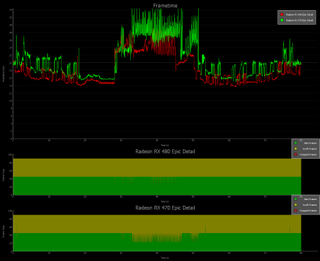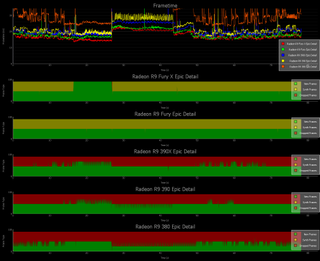FCAT VR: GPU And CPU Performance in Virtual Reality
AMD: Graphics Core Next Performance
AMD enabled support for asynchronous spacewarp on its Polaris-based cards with the Radeon Software Crimson Edition 16.10.1 driver a few months back. At one point, we had results for the Radeon RX 480, 470, and 460. But Oculus’ minimum specification cuts off at the RX 470, so we re-ran our numbers using the latest Crimson ReLive Edition 17.2.1 build and dropped the RX 460.

Both Polaris cards run in ASW mode through our test sequence, and generally render every other frame as spacewarp fills in the gaps. They do struggle with the taxing middle section though, which causes them to display more extrapolated frames than real ones by the end of our benchmark.
Superficially, it appears as if the Radeon RX 480 and 470 end up somewhere between Nvidia’s GeForce GTX 1060 6GB and 1050 Ti (but much closer to the 1060 6GB). Just remember that this is a cursory look at FCAT VR though, and not a head-to-head between Polaris and Pascal. We’re using a single game to showcase this testing tool. In the weeks to come, we’ll go wider with game selection, perhaps zeroing in on fewer cards, and start publishing performance comparisons that pit AMD and Nvidia against each other across more software. For now, it’s good to see ASW up and running on the two VR-ready models from this generation.

A while back, AMD mentioned to us that its Fiji-based cards supported ASW, but we don’t remember the company announcing this publicly. Well, here’s the proof: Radeon R9 Fury X and Fury both synthesize frames to maintain smooth performance through our Chronos benchmark run. Despite rendering at >11ms, the former even runs at greater than 90 FPS for a brief period. That’s the good news.
Unfortunately, the Hawaii- and Tonga-based boards don’t support ASW, and AMD is staying quiet on whether the feature will ever be added. What results is a mess of dropped frames that frankly looks pretty bad in-game. Dialing quality back is your best bet to enjoy this title.
MORE: Gaming At 3840x2160: Is Your PC Ready For A 4K Display
MORE: How Well Do Workstation Graphics Cards Play Games?
Stay on the Cutting Edge
Join the experts who read Tom's Hardware for the inside track on enthusiast PC tech news — and have for over 25 years. We'll send breaking news and in-depth reviews of CPUs, GPUs, AI, maker hardware and more straight to your inbox.
Current page: AMD: Graphics Core Next Performance
Prev Page Nvidia: Pascal and Maxwell Performance Next Page CPU Performance In Arizona Sunshine-
AndrewJacksonZA A really nice article and a great introduction to FCAT VR. Thanks Chris!Reply
Obvious request that probably everyone will ask of you: please include Ryzen in your tests once you have a sane moment after the hectic launch period. :-)
Now that that's out the way, I can get to my actual question: I would like to know if "Game A" is available on both the Rift and the Vive, would FCAT VR be able to tell you what, if anything, the performance difference is given the same computer hardware please?
Please can you also include multi-GPU setups. They can definitely help, depending on the title, e.g.
https://www.hardocp.com/article/2016/11/30/serious_sam_vr_mgpu_nvidia_gtx_pascal_follow_up/5
https://www.hardocp.com/article/2016/10/24/serious_sam_vr_mgpu_amd_rx_480_follow_up/
I found this statement to be very interesting: "it’s possible to illustrate that 11ms isn’t an absolute threshold for rendering new frames at 90 Hz."
Thank you
Andrew -
cangelini Hi guys,Reply
Ryzen wasn't in my lab yet when this was written, but I do have plans there ;)
Andrew, yes, FCAT VR should allow us to test the same title on two different HMDs and compare their performance.
Multi-GPU is a plan as well, particularly once games begin incorporating better support for it (right now, that's a bit of a problem). -
playingwithplato Do FCAT VR's measurement algorithms tend to favor NVDIA chipsets? Curious, wonder if AMD will release a similar testing tool to measure buffer store/retrieval and render speed <11ms? Would like to see that applied to en environment with their GPUs.Reply -
ffrgtm Fantastic article! I would love to see results with a secondary GPU (non-SLi) dedicated to physics and compare that to the cpu swap tests in AZ Sunshine you've just shown us.Reply -
ffrgtm Reply
A quote from another article on FCAT:19429997 said:Do FCAT VR's measurement algorithms tend to favor NVDIA chipsets? Curious, wonder if AMD will release a similar testing tool to measure buffer store/retrieval and render speed <11ms? Would like to see that applied to en environment with their GPUs.
"While the FCAT VR tool is developed by Nvidia, the company insists it is headset and GPU agnostic, and meant only to capture data. The tool itself doesn’t contain a benchmark; according to the company, the tool logs information directly from the VR runtime."
I'm inclined to believe Nvidia's claim of brand blindness right now... but if AMD ever manages to put forth some real competition then I don't think we could be blamed for becoming more skeptical. It's hard to forget just how far Nvidia and AMD have gone to skew results in the past. -
AndrewJacksonZA Reply
Thank you.19429089 said:Andrew, yes, FCAT VR should allow us to test the same title on two different HMDs and compare their performance.
Multi-GPU is a plan as well, particularly once games begin incorporating better support for it (right now, that's a bit of a problem).
One thing that I might've missed in the article: Has Nvidia open-sourced FCAT and FCAT VR so that everyone can see the code, check it for unbiasedness (is that even a word? :-) and help contribute to the program to make it even better? -
cangelini Yup, check it out: http://www.geforce.com/whats-new/guides/fcat-vr-download-and-how-to-guideReply
There's a download link in there. I'd be curious to hear from any TH readers who want to mess with it as well! -
thinkspeak Any chance of doing this again but with stock and OC on the maxwell, pascal and AMD cards? The 980 ti really opens up and they generally overclock well, in some cases exceeding the 1070 which would be useful for those debating an upgrading for VRReply
Most Popular



